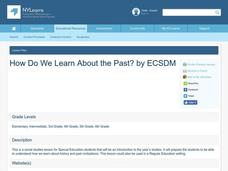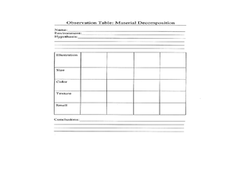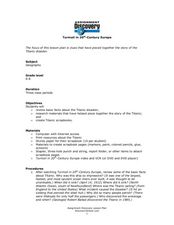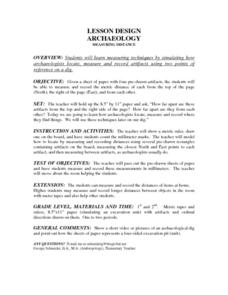Curated OER
Sticks, Stones, Sinews and Stuff: How Early People Used the Environment to Meet Basic Needs
Students create an artifact. In this early survival lesson, students use found objects to create an artifact that could have been used to help early people meet their basic needs.
Curated OER
How Do We Learn About the Past?
Young scholars examine archaeological discoveries. For this learning about the past lesson, students view a "Magic School Bus" video, discuss the role of an archeologist, and complete a graphic organizer. Young scholars discuss a variety...
Curated OER
Building Bridges for Young Learners--Culture
Young scholars explore the concept of "culture." In this cross curriculum literacy and world history lesson, students listen to a letter written by a child from Namibia, then compare and contrast life in Africa with their own life. Young...
Curated OER
What Artifacts Reveal About The Past
Students take a closer look at artifacts to learn about the people who used them. In this colonial America lesson, students examine photographs of everyday items used in colonial times and determine what the uses of the tools may be...
Curated OER
What did I find?
Students excavate an artifact. In this archaeology lesson plan, students get a bucket filled with dirt and a broken up artifact. They work in groups to take it out and to find what its purpose was.
Curated OER
Marine Archaeology
Students examine marine archaeology. In this archaeological data lesson, students see how archaeologists use data to make inferences about shipwrecks. Students read data and make their own inferences, write about marine life and...
Curated OER
Slow Rot or Not?
Fifth graders examine how environmental factors affect decomposition. In this decomposition lesson, 5th graders experiment with the decomposition of grapes in five different environmental settings. They look at images of items that have...
Curated OER
The Titanic Disaster
Seventh graders explore the titanic disaster. In this geography lesson, 7th graders research basic facts about the Titanic. Students create Titanic scrapbooks.
Curated OER
Lesson Design Archaeology- Measuring Distance
Students measure and write specific metric distances. In this archaeology lesson, students are given specific artifact locations on a map and measure the distance using millimeters.
Curated OER
The Museum Idea
Students evaluate and record the various types of museum careers. In this The Museum Idea instructional activity, students create a bicentennial time capsule, design a Museum of me, and make a classroom mini museum. In addition students...
Curated OER
The Torah Tells...
Students extract and interpret information about the Torah text to draw conclusions about ancient Hebrew life. In this Torah lesson plan students research facts and complete worksheets about the Torah. Then as a class the students form a...
Curated OER
Life in Ancient Mesopotamia
Students reconstruct and make drawings of vessels in the same manner as an archaeologist. In this archaeologist lesson plan, students each get a piece of a broken pot and they have to work together to put it back together. Once it is...
PBS
Looking for Lincoln Throughout His Life
Young historians gather information about Abraham Lincoln through a variety of activities. They match vocabulary words with pictures to create a timeline. Additionally, learners read books and articles that teach them about Lincoln's...
Curated OER
The Stories They Tell -- Graveyard Data Collection Worksheet
In this folk culture research worksheet, students use the form to record data about a graveyard that they visit to show that graveyards reflect how cultures change and differ from each other.
Curated OER
Lone Star Round-Up
Students take a virtual tour of the Capitol Visitors Center in Austin, Texas. In groups, they receive a list of the artifacts and symbols they are to look for during their exploration of the building. To end the lesson, they make a...
Curated OER
Archaeology and Storytelling
Young scholars identify and interpret both individual families and whole cultures learn about their pasts by collecting and analyzing stories and artifacts. Then they identify that not all archaeological finds readily reveal their...
Curated OER
The Family: Louisiana Family Folklore
Students explore and identify family treasures and research the history to each one. They also organize a variety of artifacts into various categories and research traditional Louisiana artifacts online. Each student draws inferences...
Curated OER
Basics of Archaeology
Middle schoolers identify what and how to complete an Archaeological excavation is conducted. They identify the transition from one layer to the next more easily if the colors of the layers are different. When creating a dig, the...
Curated OER
Social Studies: Exploring Boston's Big Dig
Students, in a high school class for autistic children, take a virtual tour of Boston's "Big Dig" and the artifacts discovered there. During weekly lab sessions, they discover the processes involved in artifact preservation. Using...
Curated OER
When Clay speaks
Learners listen as the teacher reads "When Clay Sings," by Byrd Taylor. They discuss clay, and view a variety of clay items. Students watch a video clip "Interests in One of a Kind Pots." They watch a demonstration on working with clay....
Curated OER
Real-Life History
Students collect artifacts which are part of their family/community history. They gather at home and share in the classroom at a specified time when extra care and supervision might be provided.
Curated OER
Contextual Clues
Learners observe and interpret images of artifacts in different contexts in order to recognize importance of leaving artifacts in original context to correctly understand their meaning, and observe what is surrounding object to interpret...
Curated OER
To Protect and Preserve
Learners discuss the impact of war on the Iraqi National Museum and the importance of protecting artifacts of cultural heritage. They write letters to the Milwaukee Public Museum to show support for funding for the protection of the...
Curated OER
Archaeological Inquiry
Students describe what they see as they observe an "artifact". They draw conclusions based on the information gathered to identify what the artifact might be used for and determine how old it might be.

























